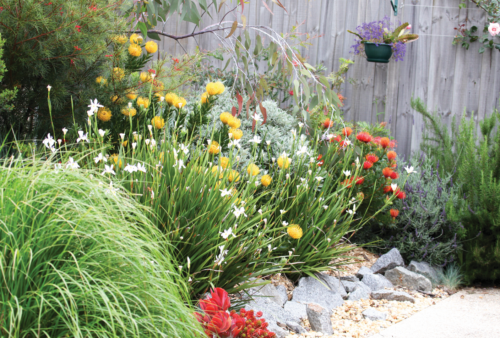We tend to think of gardens with rose bushes and flowering annuals and so are sometimes hesitant to plunge into growing native plants as we are not sure of their different needs or even if they will fit in visually. For those wanting to test out these options, try growing Australian native plants in pots!
The trend towards smaller gardens has inspired the nursery industry to develop an ever-increasing range of Australian plants for those who want to attract birds and butterflies and bring a little bit of the bush onto their verandas.
Almost all Australian plants are evergreen, which means they tend to keep growing all year round and this often leads to a longer flowering period that will attract birds and bees to your garden.
We tend to think Australian native plants belong in an informal bush garden. But they are very versatile plants that can be used in creative ways. Some of the dwarf banksias and acacias have interesting leaves that can be used to provide the same effect as dwarf conifers but with beautiful blossoms as well. Some Banksias can be clipped into formal hedges and topiaries as a substitute for box hedges, while cascading types such as Acacia pravissima and Acacia baileyana can be used as weeping standards or as hanging baskets or spilling over the edge of a tall pot.
Many of our most spectacular native plants thrive when given the extra drainage that pots provide, and then give us their best colours. These colours vary from the almost fluoro shades of Lechenaultia to the royal blues of Dampiera, the bright purples and pinks of the fan flowers (Scaevolas), the whites and yellows of paper daisies (Xerochrysum) to the contrast provided by the black kangaroo paw (Macropidia).
Most need minimal feeding and watering, though it is important that these aspects are not neglected. A handful or two (depending on plant size) of a slow (controlled) release native plant fertiliser should be sprinkled around the base of the plant after flowering. Iron deficiencies can occur in banksias and wattles and may result from soils that are too alkaline or simply iron deficient. The tell-tale signs are a yellowing in the tips of the shoots that can be improved within a couple of weeks with a handful of iron sulphate dissolved in a watering can or a dose of iron chelates.
Make sure you use a potting mix and fertilisers formulated for native plants, as plants such as banksias and acacias are known to be sensitive to phosphorous levels. The growth and size of the plant will determine when you need to repot them. Usually every couple of years should be enough as these plants tend to stay compact naturally.
Potted plants do not have the same reserves of moisture to tap into as those in the ground do, but they will not do well with over-watering. If you watch your plants and how they respond to watering you will soon know how much is too little or too much.
A large plant in a relatively small pot may need watering every day whereas a new planting may only require watering once a week until its roots grow and fill the entire volume of potting mix. Water requirements also vary on a seasonal basis with much less water required in winter when growth is slow, to peak growth in spring and summer when daily watering will usually be the norm.
THE RIGHT MIX

Look for potting mixes that are designed for Australian plants and carry the Australian Standards logo. Premium grade carries enough fertiliser to last the plant for about three months while regular grade will need fertilising at the time of potting. For an even better result in our semi-arid climate choose potting mixes with wetting agents and moisture storing granules, or add them yourself.
If you want to try out a few native plant options, consider these two and check out where they are locally available.
Fan flowers (Scaevola) are perfect for container gardening as they are fast growing and flower for up to nine months of the year, from spring through to autumn, providing beautiful purples and mauves.
The variety Purple Fanfare does well in hanging baskets but also as a trailing plant for taller pots. It requires full sun to light shade and a regular supply of water to flower at its peak. These plants are also great in mixed container plantings where they can be used to provide a colourful complement to more permanent pot plants such as the dwarf acacias and banksias.
Croweas or Correas are another option. Both belong to the Citrus family Rutaceae, which means they usually have interestingly scented foliage as well as attractive autumn/winter floral displays.
Croweas have attractive waxy star-like flowers that last particularly well on the plant as the petals hang on long after the flower has been pollinated. A light trim after flowering will help croweas to bush up during spring and summer, ensuring a great flower display for the following season. A handful of slow release fertiliser at pruning time will also help this process.
Correas do well in Broken Hill. They are low growing shrubs with beautiful hanging bell-shaped flowers in a range of colours. The tubular flowers are designed for bird pollination, so even in small courtyards you can expect regular visits from species of nectar feeding birds such as our local weebills. Correas are reliable growers that thrive in dappled light and are best suited to moderately sized pots that can be under planted with some of the colourful plants mentioned earlier. Growing requirements and maintenance of correas is identical to that of the croweas, making these two good garden companions.
So check out what smaller native varieties are available in town, find an interesting container, and see how a potted native plant can add interest and variety to your garden or veranda. You might find the idea will grow!










